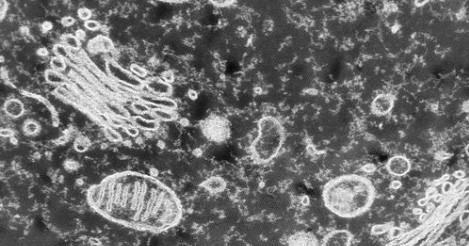
 )
)Given my interest in the metaphoric use of scientific language, I couldn’t pass up this editorial on metaphorical science experiments. Physics has made some remarkable advances in its ability to study and hypothesize about features of the universe far removed from everyday experience. Black holes aren’t on every street corner; there was just the one Big Bang; quantum entanglement doesn’t work with billiard balls. In order to pair observational data with with theoretical developments, some researchers design clever experiments on related systems that are available in the lab. The math describing the proxy systems is analogous to models for the inaccessible systems. For example, one group created sonic black holes, systems which trap sound in the way black holes trap light, and used them to explore predictions made about the behavior of regular black holes. How far does the analogy carry? It’s not clear; if we could test black holes to see if their behavior matches these sonic substitutes, we wouldn’t need the substitutes. We might be learning something or we might be tumbling down the rabbit hole.
Of course all analogies and metaphors have their limits. Hearing frequently how America needs to be healed, I’ve been wondering how far that metaphor goes. I’m sympathetic to the desire for greater harmony, understanding, and cooperation, but I’m not convinced the metaphor of healing will actually get us there. Healing as we experience it is largely passive. The most common healing scenario for may of us involves small cuts or scrapes which we cover up with a bandage and then ignore; all the work is done out of sight, microscopically. And so we say that “time heals all wounds,” a curious sort of metaphor which falls short of accuracy for literal injuries, let alone the psychological and relational damage to which it is applied by analogy. Wounds were regularly a death sentence prior to antibiotics, and even now surgery and other active interventions are frequently required (he writes, as he rehabs a surgically repaired Achilles tendon that did not heal in the 3 months prior to a correct diagnosis). At best, if we are going to talk about healing, we need to deliberately picture what individual cells do rather than our usual role.
Healing also implies an original state of wholeness disrupted by some singular incident. Was there a time when America was not divided along the lines that separate us now? Ideals of religious tolerance were tested from the start when doctrinal disagreements split communities and motivated the founding of several states. Racial and gender inequalities were explicitly written into the Constitution. I suppose it took some time for urban centers to grow large enough for meaningful contrast with rural communities, but even then a disconnect between the two is not a recent development.
Thanksgiving traditions remind us of the early European colonization of America. The work ethic of those first colonists features prominently in the stories we tell. With limited resources and labor, those settlers needed everyone to pitch in to succeed. Notions of hard work and prosperity comingled, and indeed the direct benefits of industry were readily observable in those conditions. That literal connection has been passed down to the present day in a more metaphorical sense. Most of us don’t sweat to coax crops from the ground. Some of us feed our families without ever taxing our muscles at all; working hard is an abstract function of hours and output rather than actual joules expended. Others do exert themselves physically on a daily basis, but find their share of collective resources to be wanting. The hard work and prosperity metaphor breaks down.

 )
)If we go a little further back in history, we find a successful transition from a population where every individual does more or less the same work to meet their individual needs to one where individuals specialize into dramatically different roles. Well, a lot further back. Once upon a time, all life on Earth was bacterial. Everybody was a single cell taking care of their own metabolic needs. When they did cooperate, it was a symmetrical arrangement where everyone contributed in the same way. Diversity existed mainly as a concession to different food sources available in different environments — just like Virginia colonists adapted to the farming possibilities while their Massachusetts counterparts relied more on fishing.
One day something extraordinary happened. A bacterial cell of one kind wound up completely inside a different kind of bacterial cell. Some tension or conflict may have existed initially, but ultimately a profound partnership formed that changed the world. The bacterium on the inside became the ancestor of all the mitochondria in every single one of your cells and the cells of every other multicellular organism that ever lived. Mitochondria became the power plants of those cells; they are central to all the metabolic activities that keep you going. In exchange for taking over the energy department, that bacterium and its progeny were no longer responsible for other functions like making proteins. Biologists call this relationship endosymbiosis.
What if we sought symbiosis instead of healing? Symbiosis allows us to acknowledge we are not trying to return to a state that may never have existed; instead we are trying to transform into something new. Symbiosis is an ongoing dynamic, not a finite process. Symbiosis preserves distinctiveness rather than aiming for homogeneity. Symbiosis is probably unfamiliar enough that we’ll have to actively think about how to achieve it rather than assuming it will just happen with time. And Thanksgiving dinner is a great opportunity to practice. If you can’t roast the turkey, bring a pie or do the dishes or mash some potatoes. And if you bought any of those things, give thanks for the farmers and laborers who made them available.
Note: For more on the theme of transforming America, see Josh Wu’s post-election Thanksgiving reflection and the comments thread from my previous post.
Andy has worn many hats in his life. He knows this is a dreadfully clichéd notion, but since it is also literally true he uses it anyway. Among his current metaphorical hats: husband of one wife, father of two teenagers, reader of science fiction and science fact, enthusiast of contemporary symphonic music, and chief science officer. Previous metaphorical hats include: comp bio postdoc, molecular biology grad student, InterVarsity chapter president (that one came with a literal hat), music store clerk, house painter, and mosquito trapper. Among his more unique literal hats: British bobby, captain’s hats (of varying levels of authenticity) of several specific vessels, a deerstalker from 221B Baker St, and a railroad engineer’s cap. His monthly Science in Review is drawn from his weekly Science Corner posts — Wednesdays, 8am (Eastern) on the Emerging Scholars Network Blog. His book Faith across the Multiverse is available from Hendrickson.

Leave a Reply